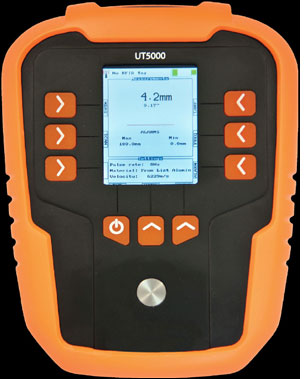Cordex Instruments, a two-year-old company headquartered in the United Kingdom, has developed a pipe-corrosion detection system that works in conjunction with high-frequency (HF) 13.56 MHz passive RFID tags. The solution will be made commercially available in mid-May in the United States, and is designed to monitor the condition of aboveground pipes that carry hazardous substances, such as oil and gas or chemicals.
The solution features the UT5000, which the company describes as an intrinsically safe handheld device combining an ultrasonic transceiver (to measure the thickness of pipe walls) and an RFID reader. Cordex is also supplying passive RFID tags that can be attached to pipes, and software that can be loaded onto an end user’s database to manage the compiled data, and to provide reports regarding the overall health of pipes at a plant, the rate at which pipes may be degrading, and how often maintenance or inspections should be scheduled. By measuring a pipe wall’s thickness and using an RFID system to establish the precise location of that measurement, users can determine whether corrosion has occurred in a specific portion of pipe, according to Nick Copeland, Cordex’s marketing manager.
The Cordex system, Copeland says, was “designed for engineers and senior technicians charged with monitoring pipeline safety and helping them to deliver true predictive maintenance.”
Cordex designed the system in response to two problems experienced by companies that own or manage hazardous substance-bearing pipes. First, gathering data about pipe quality is time-consuming, and can require a plant to shut down pipes and manually inspect each length of pipe using an ultrasonic device to measure the thickness of the pipe’s steel walls, with the results recorded on paper. In addition, data collection and analysis can be disorganized and vulnerable to mistakes, since the office staff rely on paperwork from inspectors, which must be input into the database, and mistakes can often be made. As a result, evaluating inspection results and determining the schedule for further maintenance can be difficult.
When using the system, end users attach the round RFID tags, which measure approximately 1 inch in diameter and 3 to 4 centimeters (1.2 to 1.6 inches) in thickness, to a pipe wall. They can either be attached via metal screws, cable-tied to the pipe or affixed with an adhesive. When a tag is first attached, employees use the UT 5000 handheld—which Cordex Instruments designed and manufactured—to read the unique ID number encoded to the tag, which complies with the ISO 15693-2 and 18000-3 RFID standards. The workers input data about the tag’s location on the pipe, including the location’s sector number and any other important information, such as pipe size. The handheld’s built-in ultrasonic sensor measures the pipe wall’s thickness with an accuracy of less than a half-millimeter (0.2 inch). That information, along with the tag’s unique ID, is captured by the handheld and stored. The device can store up to 1,000 readings.If there are any apparent flaws or other concerns about a section of pipe, the inspector can also utilize a camera—Cordex offers the Centurion and ToughPIX models for that application, though other digital cameras could also be used—to capture a digital image of the pipe that can later be uploaded to the office database, along with the reader’s data regarding tag ID numbers and sensor results.
Upon returning to the plant office, the inspector uploads the information to the Cordex Connect Predictive Maintenance System software. The software identifies the location, date and time of each tag reading—linked to the wall-thickness measurement results—and provides an alerting system in which a red icon indicates that a specific section of pipe requires maintenance or replacement, and a yellow icon indicates that a section of pipe may soon need another inspection or additional maintenance.
What’s more, the software allows engineers or management to monitor pipeline safety by collecting data from multiple read events, and to identify trends, thus helping them create a predictive-maintenance program. Data can be exported to Microsoft Excel, or into a CSV-format file.
The software can also detect when the UT5000’s ultrasound sensor may be out of calibration and the readings may, therefore, be inaccurate.
The Cordex system is being piloted on pipes carrying oil and gas in Aberdeen, Scotland, to test the functionality of technology in the field, Copeland says, though he declines to describe specifics of the pilot. The end user, a company responsible for maintaining oil and gas pipes, has asked not to be named.
Last year, a U.K. firm called Permasense began marketing a pipe-measuring solution consisting of an active RFID sensor network with battery-powered tags transmitting back to an interrogator, indicating the thickness of pipe walls (see BP uses RFID Sensors to Track Pipe Corrosion). Cordex’s solution, on the other hand, employs a handheld reader that inspectors would carry while walking beside the pipelines. As such, users would need to invest only in low-cost passive RFID tags (rather than active tags, each including a built-in sensor), as well as Cordex’s handheld unit and accompanying software.



